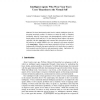Free Online Productivity Tools
i2Speak
i2Symbol
i2OCR
iTex2Img
iWeb2Print
iWeb2Shot
i2Type
iPdf2Split
iPdf2Merge
i2Bopomofo
i2Arabic
i2Style
i2Image
i2PDF
iLatex2Rtf
Sci2ools
93
Voted
IVA
2001
Springer
2001
Springer
Intelligent Agents Who Wear Your Face: Users' Reactions to the Virtual Self
The three-dimensional models used to embody intelligent agents are becoming increasingly realistic. We discuss two studies in which we embodied intelligently behaving virtual agents with photographically realistic models of human subjects' heads and faces. We then immersed those subjects with agents embodied with their virtual selves and compared their interactions and nonverbal behaviors to separate subjects who were immersed with agents embodied with virtual others. Subjects treated agents embodied with their virtual selves fundamentally differently than agents embodied with virtual others in regards to both measured nonverbal behaviors and questionnaire ratings. Implications for systems incorporating realistic embodied agents are discussed.
Embody Intelligent Agents | Intelligent Agent | IVA 2001 | Realistic Embodied Agents | Virtual Selves |
| Added | 30 Jul 2010 |
| Updated | 30 Jul 2010 |
| Type | Conference |
| Year | 2001 |
| Where | IVA |
| Authors | Jeremy N. Bailenson, Andrew C. Beall, Jim Blascovich, Mike Raimundo, Max Weisbuch |
Comments (0)

